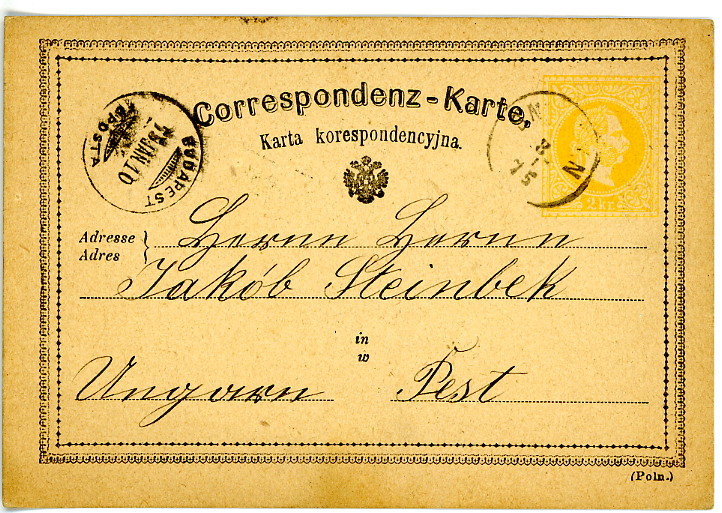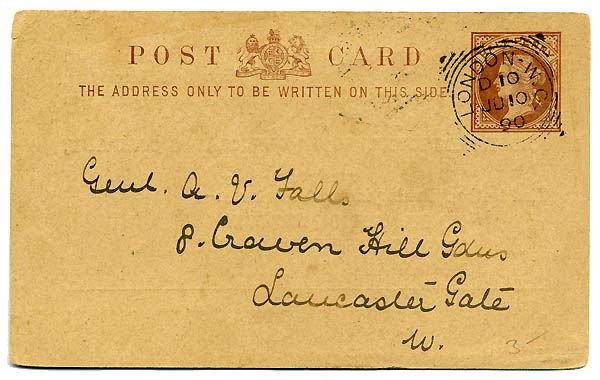Postal card on:
[Wikipedia]
[Google]
[Amazon]




 Postal cards are
Postal cards are
Postal Cards and Post Cards History
Mostly picture postcards, but some information and illustrations of postal cards.
Comprehensive Cuban collection {{Authority control Philatelic terminology Postal stationery Postcards




 Postal cards are
Postal cards are postal stationery
A piece of postal stationery is a stationery item, such as a stamped envelope, letter sheet, postal card, lettercard, aerogram or wrapper, with an imprinted stamp or inscription indicating that a specific rate of postage or related serv ...
with an imprinted stamp
In philately, an imprinted stamp is a stamp printed onto a piece of postal stationery such as a stamped envelope, postal card, letter sheet, letter card, aerogram or wrapper.Carlton, R. Scott. ''The International Encyclopedic Dictionary of ...
or indicium
In philately, indicia are markings on a mail piece (as opposed to an adhesive stamp) showing that postage has been prepaid by the sender. ''Indicia'' is the plural of the Latin word ''indicium'', meaning distinguishing marks, signs or identifyi ...
signifying the prepayment of postage. They are sold by postal authorities
This is a list of postal entities by country. It includes:
*The governmental authority responsible for postal matters.
*The Regulatory agency, regulatory authority for the postal sector. Postal regulation may include the establishment of postal po ...
. On January 26, 1869, Dr. Emanuel Herrmann of Austria
Austria, , bar, Östareich officially the Republic of Austria, is a country in the southern part of Central Europe, lying in the Eastern Alps. It is a federation of nine states, one of which is the capital, Vienna, the most populous ...
described the advantages of a ''Correspondenz Karte''. By October 1, 1869 the world's first postal card was produced by Austria-Hungary.Van Gelder, Peter J.; ''The Collectors' Guide to Postal Stationery'', A Squirrel Publication (1997) They caught on quickly. By the end of 1870, Great Britain, Finland, Switzerland and Württemberg
Württemberg ( ; ) is a historical German territory roughly corresponding to the cultural and linguistic region of Swabia. The main town of the region is Stuttgart.
Together with Baden and Hohenzollern, two other historical territories, Württ ...
joined the countries issuing postal cards. In the United States, they were first produced in 1873.Bussey, Lewis E., Ed.; ''United States Postal Card Catalog'', United Postal Stationery Society, 2010, 248 pages. A complete and authoritative look at U.S. postal cards. Some of the forms taken by postal cards include the regular single card which may be commemorative or definitive
Definitive may refer to:
* ''Definitive'' (TV series), an American music television series
* Definitive stamp, a postage stamp that is part of a regular issue of a country's stamps available for sale by the postal service
See also
* Definiten ...
, attached message-reply cards, airmail
Airmail (or air mail) is a mail transport service branded and sold on the basis of at least one leg of its journey being by air. Airmail items typically arrive more quickly than surface mail, and usually cost more to send. Airmail may be t ...
postal cards, and official postal cards used for official government business with a "penalty for private use".
To the post office, there were positive advantages to postal cards as opposed to correspondence in envelope
An envelope is a common packaging item, usually made of thin, flat material. It is designed to contain a flat object, such as a letter or card.
Traditional envelopes are made from sheets of paper cut to one of three shapes: a rhombus, a sh ...
s. The cards were lighter and less bulky than letters and they were all the same size. The result was that they occupied less than one third of the space required by the same number of letters. To the public there were also advantages. They were simple and cheap making them an instant success. Britain had a half-penny rate to begin with. The U.S. "penny postcard" rate lasted through 1951.
Presumably for the purpose of getting a prompt reply, a sender was given the opportunity to pay for postage ''both'' ways with an attached message-reply card, first introduced by Germany in 1873. Other European countries quickly followed suit. Spain furnished message-reply cards to her Colonies: Cuba (1880), Philippines (1889) and Puerto Rico (1898).Littrell, Robert, Ed.; ''Postal Cards of Spanish Colonial Cuba, Philippines and Puerto Rico'', UPSS, 2010; The U.S. issued them first in 1892. Message-reply cards were attached tête-bêche
In philately, ''tête-bêche'' (French for "head-to-tail", lit. "head-to-head") is a joined pair of stamps in which one is upside-down in relation to the other, produced intentionally or accidentally. Like any pair of stamps, a pair of ''tête- ...
and likely to be perforated or rouletted to facilitate separation once in the hands of the recipient. The recipient could then tear them apart and use the prepaid reply card to correspond with the original sender. Normally the message card would be identical to the reply card except with the distinction of having additional language such as "WITH REPLY CARD" or "''La otra tarjeta es para la respuesta''" or "''Carte Postale Résponse''" or similar words to distinguish the two. In the U.S., message and reply cards have been identical since 1968.
The term postal card is clearly differentiated from the term postcard
A postcard or post card is a piece of thick paper or thin cardboard, typically rectangular, intended for writing and mailing without an envelope. Non-rectangular shapes may also be used but are rare. There are novelty exceptions, such as wood ...
which is a term to designate cards prepared by private companies and which do not have prepaid franking. They are readily available at commercial outlets. The addition of an adhesive stamp is required to mail them. They are frequently illustrated with pictures or printed advertisements. They are ''not'' considered postal stationery any more than a plain envelope or sheet of parcel wrapping are.
References
Further reading
* Bussey, Lewis E., Ed.; ''United States Postal Card Catalog, 2010'',United Postal Stationery Society The United Postal Stationery Society (UPSS) was formed July 1, 1945 from the merger of the Postal Card Society of America, in existence since 1891, and the International Postal Stationery Society, founded 1939. Current membership stands at about 1,0 ...
(UPSS).
* Dagnall, H. ''The Evolution of British Stamped Postcards & Letter Cards: their history & documentation''. Queensbury: H. Dagnall, 1985 249p.
* Falberg, Bill, and Undersander, Dan; ''Historical Catalog of U.S. Postal Card Essays and Proofs: 1874 - 1885'', UPSS, 2008. (electronic version, 2010) 384 pages.
* Gage, Alexander D., Edward G. Fladung & Melvin Feiner (Eds.). ''Higgins & Gage World Postal Stationery Catalog''. Pasadena: Higgins & Gage, 1964-89 (19 volumes)
* Gough, James P. ''The Postal History of the Universal Postal Union: The Postal Card (Worldwide) 1869-1974''. London: Royal Philatelic Society London, 2019 935p. (2 volumes)
* Krieger, George T.; ''The Postal Stationery of the Possessions and Administrative Areas of the United States of America''; United Postal Stationery Society, 2009, .
* Littrell, Robert, Ed.; ''Postal Cards of Spanish Colonial Cuba, Philippines and Puerto Rico'', UPSS, 2010.
* Stendel, Robert; ''U.S. Domestic Postal Card Regulations'', 1874–1885, United Postal Stationery Society, 2010 edition.
* Wukasch, Ken; ''Postal Cards of the World's Columbian Exposition''; UPSS, 2005.
External links
Postal Cards and Post Cards History
Mostly picture postcards, but some information and illustrations of postal cards.
Comprehensive Cuban collection {{Authority control Philatelic terminology Postal stationery Postcards